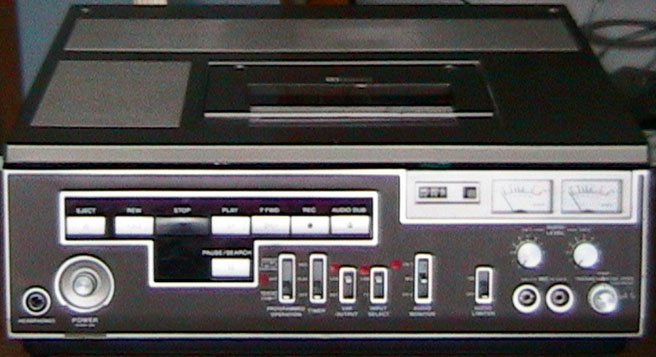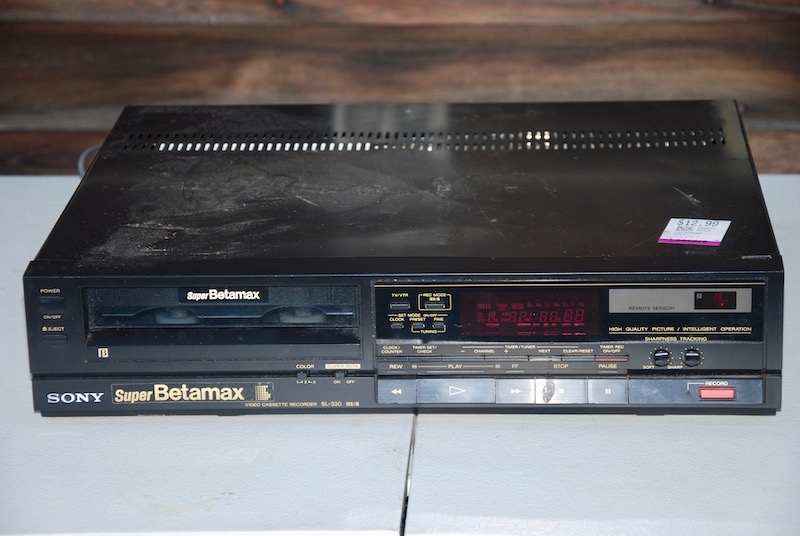

Betamax web sites
Beta Info guide - A great resource for information on all sorts of Betamax decks
Absolute Beta - A source for Beta decks, accessories, and repair
Mister Betamax - another source for Beta decks, accessories, and repair
LabGuy's World - A great page about all sorts of obsolete video technologies
Welcome to my Betamax page! Betamax was developed by Sony in the early 1970s, and was perhaps the first successful video cassette format for the consumer market (a US company called Avco had tried with "Cartrivision" a few years before, but it failed due to various reasons); it was eventually eclipsed by VHS, in spite of its superior picture quality. In with my other obsolete video equipment, I've managed to amass a number of Beta VCRs, as well as a few tapes. Not many of them work, but I'm hoping to rectify that. I am relatively-new to the Beta world, but am finding so far that it's pretty cool. I hope to soon have more photos of my Betamax equipment on this page. Stay tuned!

This is my first Beta deck, a Sony SLO-323, which dates from 1978. The SLO-323 is an industrial VTR, meaning that it lacks a tuner or timer, but was built to withstand heavy usage. Like most early industrial Betas, the SLO-323 can record and playback tapes made at the ßI speed only, meaning that it's all but useless for viewing commercially-made tapes (as well as the vast majority of home recordings!) made at the ßII and ßIII speeds, but it makes for good self-recordings. An improvement on the earlier SLO-320, the SLO-323 fixed the recording problems of it's predecessor, and added linear stereo sound (it's not hifi, but it should do). It appears to be working quite well, and makes pretty good recordings (though it's choice of inputs is rather limited, since the VHF IN jack acts as nothing more than a pass-through, and it uses BNC jacks for video input). I've done some audio-only recordings from my stereo system, but it requires that video be fed in anyways, making for a rather crude setup (I used a VHS camcorder with the lens cap on; what a downgrade!).
(picture probably coming later)
This is my second Beta deck, a Zenith Video Director model VR-9000W, which dates from 1979. Supposedly, this VCR once belonged to the late fashion designer Bill Blass; I got it in exchange for examining some tapes of his fashion shows from the mid-late '80s. Unlike the Sony SLO-323, this Zenith is a consumer deck, and can both record and play back tapes made at the ßII and ßIII speeds (in fact, there are no provisions for recording or playing back tapes made at the ßI speed, which makes it a good complement to the SLO-323!). Unfortunately, the unit's functional capacity seems to be a bit limited at the moment. Most of it's functions are rather noisy, and it's rewind function doesn't work well. This thing probably needs new parts in the drive mechanism, as well as a thorough lubrication and cleaning. More later!
(picture probably coming later)
This is my third Beta deck, a Sony SL-5400, which dates from 1979. This deck once belonged to my great-uncle, and is in excellent condition (was barely ever used, and still has its original L-250 blank tape!). The OEM version of the above Zenith VR-9000W, this unit has similar problems; it too doesn't respond to a tape being inserted into it. I hope to fix it's and the Zenith's problems someday, but I don't have high hopes (the problems likely stem from old brittle plastic parts). I now have front-loading units which are better, but would like to have a working top-loader or two at some point.
(Picture probably coming later)
This is my fourth Beta deck, a Toshiba V-M32, which dates from 1983. It is my first front-loading deck. A low end model, it is a basic monaural deck, with a 14-day 8 event timer, and some sort of CATV tuner (still with the usual preset tuning, though). According to the repair slip included with it (dating from the early '90s), it exhibits some tearing on the picture (haven't tested it yet). Hopefully, it shouldn't be too much trouble to get working.
(Picture probably coming later)
This is my fifth Beta deck, an NEC VC-N70EU, which dates from 1985. It's my second front-loading deck, and my first true Beta Hi-Fi VCR. It was NEC's second-to-last Betamax VCR model, and one of their high-end models (their last model, the SuperBeta-capable VC-N65EU, actually cost and did less). I have yet to test it's operational capacity, but it likely needs some repair work. However, once repaired, it should be able to handle just about every Beta tape I have (though I'm not sure if it can manage ßI speed), and then some.
(Picture probably coming later)
This is my sixth Beta deck, a Sony SL-HF2100, which dates from 1991. It's my third front-loading deck, and undoubtedly the best Betamax deck I own. The SL-HF2100 was Sony's second-to-last consumer Betamax model, and they really pulled out all the stops for it (oddly, the very last model, the SL-HF2000, was little more than a stripped-down version of the 2100, similar to the NEC listed above). It commemorated the 15th anniversary of the Betamax format by being different than any VCR before (or perhaps since); both the VCR itself and its remote (which, sadly, I don't have) are based entirely around touch-panel technology rather than conventional buttons and switches. Feature-wise, it is loaded with them, including "SuperBeta" hi-band recording mode ("Super High Band" mode in ßI), S-video jacks for input and output, and auto-tracking. These are still very much sought-after by Betamax collectors, commanding premium prices on eBay, but I was lucky to get a very good deal on mine. It currently has major issues with the picture quality, but hopefully that won't be too hard to clear up.
(Picture probably coming later)
This is my seventh Beta deck, a Sony SL-HF900, which dates from 1985. The most popular Beta VCR model, according to BetaInfoGuide, the SL-HF900 sports the "SuperBeta" record mode, which offers improved quality over regular recording (similar to S-VHS, which was JVC's answer to SuperBeta). It also offers hi-fi stereo recording, a set of editing controls (including a set of jog/shutter dials) and many other features. When first tested, this deck doesn't seem to do much, though hopefully it's just a case of needing new belts and whatnot. Stay tuned!

This is my eighth Beta deck, a Sony SL-330 from 1988. Like the SL-HF900 mentioned above, it offers "SuperBeta" recording mode, though only mono audio (Sony offered a stereo version as the SL-HF360). This was a far more basic deck from the 'decline' era of the format as a consumer medium, not long before the SL-HF2100 and 2000 hit the market as its swansong. I have yet to do much testing with this deck.
Site Navigation:
Go back to the other stuff page!
Go back to the main page!